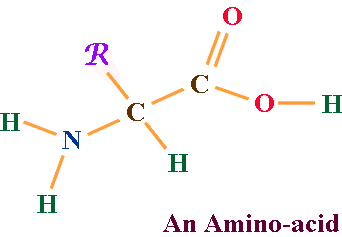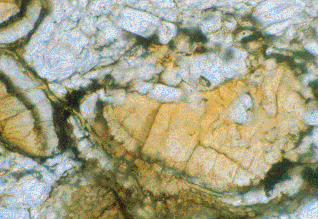Life
on Earth and on other Worlds?
Search for Extra
Terrestrial
Intelligence (SETI) |

Almost 15 billion years
ago - in an explosion like no other - the Universe was created. Within
three minutes of the Big Bang,
all
the Hydrogen and almost all the Helium that we observe today were
produced.
The Universe, for the most part, was homogeneous and isotropic. Yet,
some
minute fluctuations, recently detected by the COBE
satellite, became seeds for galaxy formation. Around these
"galactic
seeds" matter started to clump; first slowly and then
faster
and faster, because of their large gravitational attraction. In this
way
the first generation of stars and galaxies were born 1 billion years
after
the Big Bang. Some of these first-generation stars were so massive that
they lived for only one million years. Yet, these were
incredibly-efficient
nuclear furnaces - arranging protons and neutrons in new partnerships
that
resulted in heavier elements, such as Carbon,
Nitrogen, Oxygen, and many others. Moreover, these massive
stars
did not die quietly. Rather, they died in spectacular
supernova
explosions that scattered all the heavy elements into space.
These new elements got incorporated into the interstellar medium,
leading
to new galaxies and stars. Within three billion years of the Big Bang,
a galaxy forms in a part of the Universe like many others. This
newly-formed
spiral galaxy, containing 100 billion of stars and extending for about
100,000 light years, is our galaxy:
The Milky
Way. Suddenly, in one of the spiral arms of the galaxy, a
star,
not too large not too small, with a mass of 2x1030 kilograms
is born. After some time, our Sun,
becomes
hot enough to fuse hydrogen and blows away most of the gas and dust
cocoon.
Nine planets are born.
One of them - our planet
Earth - starts to revolve around the Sun in an orbit that is neither to far
nor
too close, but just right. Right and ripe enough for the formation of LIFE.


Stars must die ... So we can
live
So we are back were we started at the beginning of the
semester: taking a cosmic
journey. Now, however, we are all wiser and know that the journey
should
have started with the last, rather than with the first, frame.
Historical
Perspective:
1802 -- William
Paley published a forcefully argued treatise entitled: "Natural
Theology or Evidences of the Existence and Attributes of the Deity
Collected
from the Appearances of Nature". This is perhaps the
best-known
work that uses the 'Argument from Design' thesis
to argue for the existence of a creator. The Design
Argument suggest that living systems are so well-adapted to
their
purpose, and so incredibly complex, that they couldn't have arisen by
chance.
Rather, they appear to have been designed by a: Supreme
Designer.
For example, take the molecule of hemoglobin
(the blood transporter of Oxygen) which consists of 4 chains of amino
acids
twisted together. Each chain contains 146 amino acids. Life on Earth is
based on 20 different kinds of amino
acid. Therefore, the number of different ways of making a chain of
146 amino acids from 20 different building blocks is 20 multiplied by
itself
146 times, since at each position in the chain one can place any one of
20 amino acids. That number is 20146or
about 10190 !
Now
suppose that you take the fastest ever built Teraflop (trillion
operations
per second) computer and start constructing combinations at random for
as long as the Universe has existed, which is 1018
seconds.
This will let you construct only
1030
combinations.
Chance alone cannot
lead to LIFE. Thus, the argument in favor of a Supreme
Designer
(or Creator) seems utterly compelling. Indeed, for more than fifty
years
Paley's argument was never questioned. Shortly after that, however, a
purely
natural way to achieve adapted complexity was discovered.
1859 -- Charles
Darwin published The Origin of Species. This is arguably
the
most revolutionary work in the history of science. Darwin's basic idea
is very simple. So simple, in fact, that it is frequently
misunderstood.
He recognized a purely natural way to obtain highly adapted complex
organisms
through:
Complexity -
which
can arise as a result of the cumulative
effect
of
small random mutations;
Adaptation -
as
the
result of a selection effect.
Namely,
if the mutations confer advantage to the chance of an organism to
survive,
the mutation will be adopted and will be passed on to the next
generation.
If, however, a mutation reduces the chance of survival, then that
mutation
is less likely to be passed on to the next generation because the
organism
may perish before it reproduces. Thus, over many generations the
survivors
will obviously be those organisms that are best able to adapt and
survive.
This selection effect is called Natural
Selection.
It is important to understand that, unlike
evolution
by artificial selection, evolution by natural selection, is undirected
and goal-free. There is no aim: what survives is what works best at the
moment on that environment. If evolution by natural selection has,
indeed,
occurred on Earth, then can it occur elsewhere.


Are We Alone?
Our galaxy contains about 100 billion stars, while the
known Universe contains about as many galaxies. Given the immense
number
of stars in the Universe it seems reasonable to ask if we are alone? I
am sure that the answer to this question is extremely important to
everyone
of us - independent of the outcome.
Carbon-based Life forms:
The basic building blocks of Carbon-based life as we
know it are organic molecules.
Such
molecules are spread throughout the Universe. An immediate question is:
how easy is it to go from these simple organic molecules to the
building
blocks of life? This question was answered in a classic experiment
performed
in 1952 by the American chemists Stanley
Miller
and Harold Urey.
They
showed
that simple molecules can combine to form the molecular building blocks
of carbon-based life forms under conditions that are believed to have
existed
on the Earth in its early history.


A diagram of the Miller-Urey Experiment, where simple
compounds are shocked to produce four amino acids, fatty acids, and
urea.
Of course, this success is only the first step
towards
life forms. Somehow we have to get from the amino acids to
self-replicating
molecules. This is where natural selection proves crucial: although the
chance of producing the right combination of amino acids to create a
viable
replicating molecule is essentially zero, it is possible, through
natural
selection, to get to such a molecule by the cumulative effect of small
random changes in a large pool of randomly created molecules. Over
time,
the population of the more stable, better adapted, molecules would grow
at the expense of less stable, less well adapted molecules.
The Best Candidate to
Date:
ALH 84001
Meteorite ALH 84001 (for Allan Hills) was found on the
Antarctic ice in 1984 and only recently recognized as one of 12
meteorites
believed to have come from Mars. How do we
know
it is from Mars? Because we are very lucky! ALH 84001
contains
gases trapped in small glassy "bubbles". A careful analysis of these
gases
revealed that they have the same composition and abundance as the gases
in the Martian atmosphere measured by the two Viking explorers that
landed
in 1976. The chemical abundances are like fingerprints and they match
exactly.
It now seems likely that ALH 84001 was blasted off the surface of Mars
when a comet or asteroid struck the planet (and killed all the martian
dinosaurs, just kidding!) Chemical, mineral, and fossil evidence
suggest
that ALH 84001 once contained LIFE.
Traces
of amino acids were found in the meteorite which supports the idea that
the building blocks for life are common in the Universe. It
doesn't prove, however, that there was past life on Mars; it doesn't
prove
that there was not either.


To summarize, the Science
paper of McKay leaves many unanswered questions. As they
forthrightly
state, their paper is NOT PROOF OF LIFE ON
MARS.
Their
paper presents evidence that, on its surface, is consistent with
ancient
life on Mars; McKay believes that the evidence is more consistent with
life on Mars than any other explanation. Almost all of their
conclusions
can be disputed and will likely be disputed.
Allan H. Treiman,
Lunar
and Planetary Institute
August 21, 1996
How to Find "Them"
We believe that the best way to find Extra
Terrestrial
civilizations is to listen to possible radio emission that they might
be
sending. But where to look? If we look at the background radio noise
from
the universe it turns out that the noise level is a minimum at the
``Water
Hole"- the radio frequency range from 1000 to 10,000 MHz - that is
close
to the microwave emission lines of H and OH; it includes the
21-cm emission line (1,429 MHz) from hydrogen, of obvious
universal
importance.
Astronomer
Frank Drake
launched in 1960 the first modern search for alien radio signals. Using
the radio telescope at the Radio Astronomy Observatory in West
Virginia,
Drake analyzed the signal coming from two stars - Tau Ceti and Epsilon
Eridani - for beacons at 21 cm. His effort - called Project Ozma,
marked
the birth of a new scientific field: The
Search
for ExtraTerrestrial Intelligence. Since then many people
have
been scanning the Universe for signs of intelligent life, so far
without
success. However, the recent discovery of extrasolar
planets enhances the probability that we are not alone, because if
solar systems are commonplace then it is more probable that a planet
like
the Earth can exist elsewhere. However, we should not expect the
species
on these other worlds, if they exist, to be necessarily C-based life
forms
like those on Earth. Let's use the Drake
equation to compute the probability of ETI.
Flying Toasters vs SETI:
We all can join together in the quest for SETI. SETI
research consists primarily of radio astronomers searching for
narrow-bandwidth
radio signals (radio waves are able to penetrate interstellar medium).
SETI@home is a scientific experiment that will harness the power of hundreds of
thousands
of Internet-connected computer. You can participate by running a
program
that downloads and analyzes radio telescope data. There's a small but
captivating
possibility that
your computer will detect the
faint murmur of a civilization beyond Earth. To
participate in SETI@HOME, you'll need a computer with at least 32 MB of
RAM, 10 MB of disk space, and an Internet connection (dialup is OK).
There
are plans to support Win95, Win98, WinNT, Mac, and many versions of
UNIX,
including Linux on various CPUs. It doesn't matter where in the world
you
live. For more information read the article in the April 1999 issue of
Discover Magazine.

The
Arecibo Message:
This message was sent on November 16, 1974 from the
Arecibo
Observatory in Puerto Rico, consisted of 1,679 bits of information,
which
is only divisible by two prime numbers - 73 and 23 - which suggests
laying
out the message in those dimensions, revealing this image. The picture
shows our chemical makeup, our population, our height, our planetary
system,
and the telescope transmitting the message. The message was aimed at
the
M13 globular cluster; it will reach its destination in about 25,000
years.


SO, ARE WE ALONE?
WE
DON'T
KNOW THE ANSWER TO THAT QUESTION YET. BUT IF IT
IS
ONLY JUST US .... IT SEEMS LIKE AN AWFUL WASTE OF SPACE.
Let's go and see the Stars
The Milky Way
or
even Mars
Where it could just be ours
Let's fade into the Sun
Let
your spirit fly










